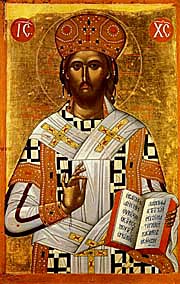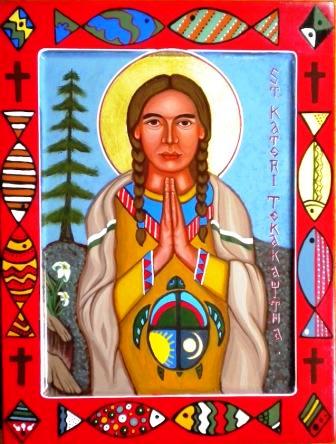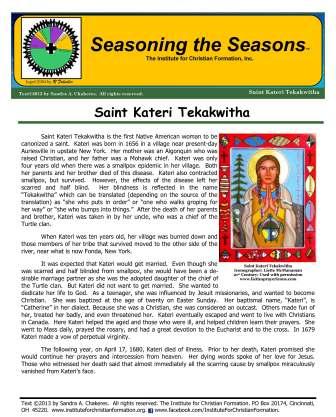The Institute for Christian Formation

Saint Kateri Tekakwitha, Virgin
Feast Day (Memorial): July 14 in USA*
(*April 17 in Canada)
Follow us on Facebook to keep up to date with our news and newest resources!
Saint Kateri Tekakwitha is the first Native American woman to be canonized a saint. Kateri was born in 1656 in a village near present-day Auriesville in upstate New York. Her mother was an Algonquin who was raised Christian, and her father was a Mohawk chief. Kateri was only four years old when there was a smallpox epidemic in her village. Both her parents and her brother died of this disease. Kateri also contracted smallpox, but survived. However, the effects of the disease left her scarred and half blind. Her blindness is reflected in the name “Tekakwitha” which can be translated (depending on the source of the translation) as “she who puts in order” or “one who walks groping for her way” or “she who bumps into things.” After the death of her parents and brother, Kateri was taken in by her uncle, who was a chief of the Turtle clan.
Saint Kateri Tekakwitha
Iconographer: Liette McManaman
21st Century; Used with permission
www.liettesprayericons.com
When Kateri was ten years old, her village was burned down and those members of her tribe that survived moved to the other side of the river, near what is now Fonda, New York.
It was expected that Kateri would get married. Even though she was scarred and half blinded from smallpox, she would have been a desirable marriage partner as she was the adopted daughter of the chief of the Turtle clan. But Kateri did not want to get married. She wanted to dedicate her life to God. As a teenager, she was influenced by Jesuit missionaries, and wanted to become Christian. She was baptized at the age of twenty on Easter Sunday. Her baptismal name, “Kateri”, is “Catherine” in her dialect. Because she was a Christian, she was considered an outcast. Others made fun of her, treated her badly, and even threatened her. Kateri eventually escaped and went to live with Christians in Canada. Here Kateri helped the aged and those who were ill, and helped children learn their prayers. She went to Mass daily, prayed the rosary, and had a great devotion to the Eucharist and to the cross. In 1679 Kateri made a vow of perpetual virginity.
Celebrate Saint Kateri Tekakwitha with Children and Youth
•Children can perform a brief play about Saint Kateri’s life. Loyola Press has a Kateri play/skit online.
•Talk about Kateri’s life using the symbolism in the prayer card referenced above in the Kateri resources section.
•Let children color a picture of Saint Kateri (note that in this coloring page, Kateri is still listed as “Blessed” rather than “Saint” – another teachable moment about the steps in the canonization process!
•Conclude with Saint Kateri refreshments/treats. Make cookies in the shape of lilies (Kateri is the Lily of the Mohawks) or a turtle (Kateri was a member of the Turtle Clan, of which her uncle – who raised her after her parents died – was chief). You can even go all out and make these “Pull Apart Turtle Cupcakes” from Betty Crocker. Here is the link to the recipe. But before you eat, celebrate this Saint Kateri Prayer Service from the Tekakwitha Conference. Then give each person a small coin envelope containing seeds for the “Three Sisters” – corn, beans, and squash!

Click image above to download our ICF bulletin on Saint Kateri Tekakwitha.
The following year, on April 17, 1680, Kateri died of illness. Prior to her death, Kateri promised she would continue her prayers and intercession from heaven. Her dying words spoke of her love for Jesus. Those who witnessed her death said that almost immediately all the scarring caused by smallpox miraculously vanished from Kateri’s face.
Kateri Tekakwitha is buried in Kahnawake, Quebec, Canada. You can travel there and visit her tomb. 300 years after her death, on June 22, 1980, Pope John Paul II beatified Kateri. Pope Benedict XVI canonized her on October 21, 2012. You can read the homily from the canonization ceremony here, and also watch the video of her canonization and view photos.
Her feast day is July 14 in the United States and April 17 in Canada. Saint Kateri Tekakwitha is known as “The Lily of the Mohawks.” A lily is a sign of purity. Kateri loved to garden, and is a patron saint of the environment and ecology.
Links to more resources on Saint Kateri Tekakwitha
•Here is the home page of the National Kateri Shrine.
•The Black and Indian Mission Office have information about Kateri, including a novena and a downloadable tri-fold brochure about Kateri.
•The Tekakwitha Conference has a prayer card (learn more about the symbolism in the art here), a Kateri prayer, and links to five other prayers (two litanies, a prayer service, a prayer in four directions, and a prayer in six directions).
•Salt and Light TV’s page on Kateri includes information as well as several videos which can be viewed from the page.

Saint Kateri Tekakwitha is a popular saint with people of all ages. Here is a great way to celebrate her life with young people.
•Tell Saint Kateri’s story. You can use our ICF Saint Kateri handout. Kateri Television also has a lesson plan/study guide and a video which can be viewed.
Saint Kateri Tekakwitha, pray for us!
